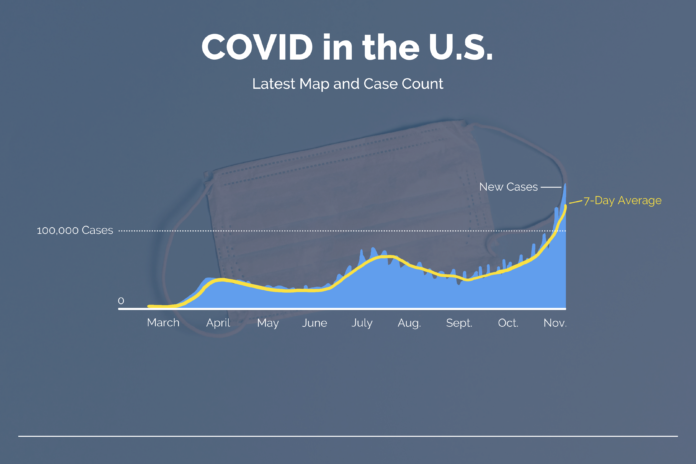Daily cases and hospitalizations have peaked sooner than experts had expected
Despite promising developments in the race to find a COVID-19 vaccine, cases of infection have increased in all 50 states during the past few weeks, according to NBC News. The number of daily cases in the United States hit an all time high this month, and hospitals around the country have experienced a record-breaking influx of patients infected with COVID-19. A press release by UC Davis Health revealed that the number of positive COVID-19 tests in the Sacramento region has doubled in the past month.
“This virus continues to surprise us,” said Shaina Kaye, a medical resident in the UC Davis Department of Pediatrics, via email. “What is not surprising is that COVID-19 reached an all-time high from the steady increase over the past weeks.”
Although she had not expected this increase to be as early in the flu season as results have shown, Kaye—like many other physicians—had expected it to occur. She expressed that this increase is associated with the way people have been behaving and following social distancing orders over the past couple of months. More opportunities for transmission have occurred due to restaurants, gyms and other facilities opening up to the public.
“With the easing of restrictions, colder weather and people experiencing ‘COVID-19 and quarantine fatigue,’ more people interact in closer proximity,” Kaye said via email.
Because of this recent increase in cases, Yolo County has shifted from being in the red tier to the more restrictive purple tier, according to a press release. Jenny Tan, the public information officer at Yolo County, explained that although they had predicted a surge in cases with the holiday season coming up, they had hoped people would listen to guidelines they had implemented before Halloween to encourage residents to gather as safely as possible.
“The state is looking at the statewide issues, and so they don’t really look at the local causes,” Tan said. “So it’s up to the counties and cities to really look at what are the causes that are here in our communities and then to address those causes.”
Tan explained how the majority of the cases from Yolo County have been linked to household exposures, workplace exposures and social gatherings. Although the message has been repeated many times, Tan emphasized that wearing face coverings and staying six feet away from others are still the best preventative measures one can take. With the holiday season continuing as Thanksgiving and Christmas are approaching, Tan encourages residents to gather less or not at all if they can, as the risk for COVID-19 increases with the number of interactions with people.
“We get it. Everyone is so tired of COVID,” Tan said. “We’re so tired of being by
ourselves. I heard someone say today that they’ve given their dog more attention in the last nine months than in the last 10 years. But that doesn’t negate the fact that COVID is still here and we still need to follow these rules until […] there’s a way for us to overcome COVID-19.”
Wang Liao, an assistant professor in the communication department, explained how this “quarantine fatigue” can cause people to become desensitized to information about COVID-19, leading to a decrease in the risk perception of the pandemic. Liao, along with other UC Davis faculty members, surveyed how people’s use of the internet and social media sites is related to how seriously they take COVID-19 preventative measures.
“There are two important reason[s] behind whether people [take preventative measures],” Liao said. “One is their perception of the risk. The other is whether they think they can do it, whether they have the self-confidence in implementing those things or whether in general they believe those methods, like wearing masks are useful or not.”
Liao described the results from a study he conducted back in April and May of this year, when he claimed internet usage is a “double-edged sword.” He explained that on one hand, when people learn new information about the virus through the internet, their risk perception can be enhanced to take more preventative measures. On the other hand, when it comes to the emotional aspects of social media, ambiguity arises. People’s expression of emotions or emotional support through social media sites could increase others’ beliefs in the severity of COVID-19 and lead to more preventative measures being taken. It can also, however, exacerbate their risk perception to the point where people are not confident enough of their ability to protect themselves.
“I think at this point the issue is not a simple communication issue,” Liao said. “It starts to engage with very different aspects of everyday life: people’s daily practices, their social contacts, their political beliefs and also this uncertainty towards when this pandemic will be over. It just becomes much more complicated than we thought before.”
Although he initially conducted a study on the use of social media sites to predict the number of COVID-19 cases back in May, Liao stated that the pandemic has become so complex that social media or the internet’s effect on people’s beliefs and behaviors is no longer as straightforward as it used to be. He explained that it would be much harder to conduct the same study now, as there are so many factors to consider when looking at one’s risk perceptions.
Kaye mentioned that if individuals do not change their behaviors to more consciously implement COVID-19 preventative measures, the number of COVID-19 cases will continue to rise as the flu season progresses. Especially with colder weather and more indoor activities occurring, there is an increased risk for transmission in close proximity interactions.
“Students should absolutely be taking precautions during this season, especially since they may be going home to multigenerational families,” Kaye said via email. “A Zoom Thanksgiving is much better than a hospitalized Christmas.”
Written by: Michelle Wong —science@theaggie.org




